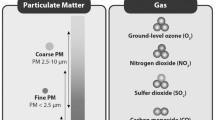Abstract
A tripartite participation of government, trade unions and university was formed in 1988 to study the situation of industrial noise and hearing acuity of workers. Since 1982, the six industries identified by the Noise Control Office were construction, electronics, metals, plastics, shipbuilding and repairing, and textiles. Safety-subcommittees were formed. With the help of these subcommittees, 21 out of 32 medium-size factories responded to the study. A total of 922 sound measurements were made and 1062 out of 10724 workers were examined. More than one third (37.5%) of workers worked in locations with noise level in excess of L eq (8h) 90 dBA. Among examined subjects, 39.8% were exposed to L eq (8) 90 dBA and above and 18.6% were found to have industrial hearing loss. Multiple logistic regression analyses adjusted for sex and age showed that for hearing loss, the important risk factors were duration of occupational noise exposure, noise intensity, floor vibration and military experience. Current legislation and measures in hearing conservation were inadequate despite the implementation of inspection by the Noise Control Office. Recommendations were directed at amending relevant legislation, increasing supervision of use of personal ear protection, and strengthening health education and audiometric surveillance of exposed workers.
Similar content being viewed by others
References
Breslow, N. E. and Day, N. E.: 1980, ‘The analysis of case-control studies’, Statistical Methods in Cancer Research, Vol. 1., Scientific publication No. 32, Lyon: IARC.
Code of Practice: 1982, The Protection of Hearing in Industrial Undertakings, Labour Department, Hong Kong Government.
Code of Practice: 1982, Reducing the Exposure of Employed Persons to Noise, HMSO: London.
Evans, W. A. and Hui, Y. M.: 1982, ‘Industrial noise-induced hearing loss in Hong Kong — a comparative study’, Annals of Occupational Hygiene 25, 63–80.
Health and Safety Executive: 1978, Discussion Document: Audiology in Industry, HMSO: London.
ILO: 1986, International Standard Classification of Occupations Fifth Impression, Revised Edition 1968, International Labour Office: Geneva.
Klockhoff, I., Drettner, B. and Svedberg, A.: 1974, ‘Computerised classification of the results of screening audiometry ingroups of persons exposed to noise’, Audiology, 13, 326–334.
Protection of Hearing at Work: 1981, Content of proposed Regulations and draft Approved Code of Practice and Guidance Note, HMSO: London.
England, J. and Rear, J.: 1981, ‘Health and Safety at work’, Industrial Relations and Laws in Hong Kong, Oxford University Press: Hong Kong.
Social Security Regulations: 1975, PD A10 Occupational Deafness, Prescribed Diseases, Part I of Schedule 1, List of noisy processes for ascertaining exposure to noise based on occupational history, United Kingdom.
Author information
Authors and Affiliations
Rights and permissions
About this article
Cite this article
Chew, T.T., Lin, W.L.T. Major factors of industrial noise-induced hearing loss in Hong Kong. Environ Monit Assess 19, 525–537 (1991). https://doi.org/10.1007/BF00401339
Issue Date:
DOI: https://doi.org/10.1007/BF00401339




